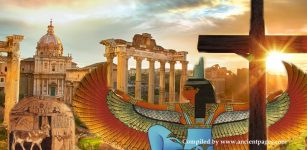Mystery Of Queen Semiramis: Famous And Powerful Ancient Ruler And Warrior Queen
Ellen Lloyd - AncientPages.com - Queen Semiramis was one of the most interesting, famous, and powerful figures in ancient history and yet, her life is shrouded in mystery because very little is known about this ancient warrior queen.
Queen Semiramis (Sammu-Ramat) was the legendary wife of King Ninus, succeeding him to the throne of Assyria and she ruled the Assyrian Empire between 811-806 B.C.
Her achievements and influence made her a controversial, famous and power ancient ruler. Ancient places in Assyria, Mesopotamia, Asia Minor, Arabia, and the Caucasus were named after her.
Even in the Middle Ages, and an old name of the Armenian city of Van was Shamiramagerd (in Armenian it means created by Semiramis).
Early Life Of Queen Semiramis
Ancient legends tell this mysterious woman was the daughter of the fish goddess Derketo of Ascalon in Syria and a mortal man. When Semiramis was just a small baby, her mother abandoned her and drowned herself. Doves fed the child until Simmas, the royal shepherd, found and raised her. That’s also the reason why Semiramis is associated with doves.
The Shepherd finds the Babe Semiramis by Ernest Wallcousins (1915).
As a young woman, Semiramis married Onnes or Menones, one of Ninus' generals. Stories of King Ninus, the eponymous founder of Nineveh and Queen Semiramis first appear in the history of Persia written by Ctesias of Cnidus (c. 400 BC), who claimed, as court physician to Artaxerxes II, to have access to the royal historical records. Ctesias' account was later expanded on by Diodorus Siculus, an ancient Greek historian.
King Ninus was deeply impressed by Semiramis and considered her to be a very brave woman. He asked Onnes if the could exchange wives offering him his own daughter, but Onnes refused. King Ninus then threatened Onnes “to put out his eyes unless he at once acceded to his commands.” Onnes was so scarred that he committed suicide.
Semiramis and King Ninus got married, got a son named Ninyas, but their family happiness did not last long.
Semiramis Becomes Queen Of The Assyrian Empire
After King Ninus conquered Asia, including the Bactrian kingdom, he was fatally wounded by an arrow. Semiramis then masqueraded as her son and tricked her late husband's army into following her instructions because they thought these came from their new ruler.
When King Ninus died, Semiramis became the ruler of Assyria. She reigned for 42 years and during this time she successfully conquered many territories in Asia. There is no doubt Queen Semiramis was a great ruler or she wouldn’t have been able to maintain the throne. Women were not admitted to positions of authority in the Assyrian Empire, and to have a woman ruler would have been unthinkable unless that particular woman had enough power to take and hold it.
Semiramis hearing of the insurrection at Babylon by Giovanni Francesco Barbieri, 1624 (Museum of Fine Arts, Boston)
Queen Semiramis restored also ancient Babylon and protected it with a high brick wall that completely surrounded the city. Then, she raised several palaces in Persia, including Ecbatana. Hungry for power, she also added Libya and Aethiopia to her already large empire.
When she went to war with King Stabrobates of India, she ordered her artisans to create an army of false elephants to deceive the Indians into thinking she had acquired real elephants. This succeeded at first, but then she was wounded in the counterattack and her army again retreated west of the Indus.
Queen Semiramis Was Killed By Her Own Son
In spite of her cleverness, Queen Semiramis also sowed the seeds of her own destruction. When her son grew older, he demanded of her mother to be installed as king, but Queen Semiramis refused, seeing him as a challenge to her own position. She then tried to kill him, but her son quickly grabbed a sword and killed her
Why Is Queen Semiramis Shrouded In Mystery?
When tracing the life and death of Queen Semiramis we encounter many histories written in ancient times. Some of these stories contradict each other making it very difficult to learn the truth about Queen Semiramis. Surprisingly, for someone so famous, very little is actually known about her.
Flemish tapestry of Queen Semiramis and her servants, c. 1480 CE, now in the Honolulu Academy of Arts.
In his book The Two Babylons (1853), Christian minister Alexander Hislop maintained that Semiramis invented polytheism and goddess worship. Hislop believed that Semiramis was a consort of Nimrod, builder of the Bible's Tower of Babel. The problem with his theory is there is no mention of Nimrod's consorts in the Bible. Hislop also stated Queen Semiramis was actually the goddess Ishtar and her son was Gilgamesh.
The identity of Semiramis continues to be argued by modern historians, but there is no doubt this woman did exist and she was a very impressive and very powerful Assyrian queen. Tales of her accomplishments reached many parts of the world. In Northern Europe female rulers tried to resemble her. Semiramis of the North was a designation given to powerful female monarchs Margaret I of Denmark and Catherine the Great.
Written by Ellen Lloyd - AncientPages.com
Copyright © AncientPages.com All rights reserved. This material may not be published, broadcast, rewritten or redistributed in whole or part without the express written permission of AncientPages.com
More From Ancient Pages
-
 On This Day In History: Fatal Fire Broke Out In Tre Kronor “Three Crowns” Castle, Stockholm, Sweden – On May 7, 1697
News | Dec 7, 2021
On This Day In History: Fatal Fire Broke Out In Tre Kronor “Three Crowns” Castle, Stockholm, Sweden – On May 7, 1697
News | Dec 7, 2021 -
 Middle Iron Age And Roman Period Buildings And Relics Discovered In Bedfordshire, UK
Archaeology | Feb 27, 2022
Middle Iron Age And Roman Period Buildings And Relics Discovered In Bedfordshire, UK
Archaeology | Feb 27, 2022 -
 Code Of Nesilim: Ancient Laws Of The Hittites
Ancient History Facts | Jun 14, 2018
Code Of Nesilim: Ancient Laws Of The Hittites
Ancient History Facts | Jun 14, 2018 -
 3,400-Year-Old Cuneiform Tablet Excavated In Old City Of Alalah
Archaeology | Aug 23, 2020
3,400-Year-Old Cuneiform Tablet Excavated In Old City Of Alalah
Archaeology | Aug 23, 2020 -
 Tracking Prehistoric Relations With AI From The Middle Stone Age To Antiquity
Archaeology | Jul 14, 2023
Tracking Prehistoric Relations With AI From The Middle Stone Age To Antiquity
Archaeology | Jul 14, 2023 -
 The Indigenous Artists Keeping Ancient Rock Art Traditions Alive For Future Generations
Archaeology | Oct 3, 2024
The Indigenous Artists Keeping Ancient Rock Art Traditions Alive For Future Generations
Archaeology | Oct 3, 2024 -
 Amazing Underground Ancient Roman City Discovered In Italy
Archaeology | Jun 12, 2020
Amazing Underground Ancient Roman City Discovered In Italy
Archaeology | Jun 12, 2020 -
 Last Of The Giant Camels And Archaic Humans Lived Together In Mongolia Until 27,000 Years Ago
Fossils | Mar 24, 2022
Last Of The Giant Camels And Archaic Humans Lived Together In Mongolia Until 27,000 Years Ago
Fossils | Mar 24, 2022 -
 Unusual Carved Stone Pillar With ‘Special Powers’ Discovered In Canada Confirmed Authentic Indigenous Artifact
Archaeology | Jan 29, 2021
Unusual Carved Stone Pillar With ‘Special Powers’ Discovered In Canada Confirmed Authentic Indigenous Artifact
Archaeology | Jan 29, 2021 -
 Egyptian Gods’ Battle For Ancient Rome – Apis And Isis Cult Against Christianity
Ancient History Facts | Feb 9, 2018
Egyptian Gods’ Battle For Ancient Rome – Apis And Isis Cult Against Christianity
Ancient History Facts | Feb 9, 2018 -
 On This Day In History: The Mongol Conqueror Genghis Khan Died – On August 18, 1227
News | Aug 18, 2016
On This Day In History: The Mongol Conqueror Genghis Khan Died – On August 18, 1227
News | Aug 18, 2016 -
 Stolen Artifacts Returned To Pompeii – Believed To Be Cursed -They Brought Misfortunes To A Woman And Her Family
Artifacts | Oct 13, 2020
Stolen Artifacts Returned To Pompeii – Believed To Be Cursed -They Brought Misfortunes To A Woman And Her Family
Artifacts | Oct 13, 2020 -
 Ehecatl: The Snake-Bird Deity And God Of Wind Feared And Respected By The Aztecs
Aztec Mythology | Aug 26, 2016
Ehecatl: The Snake-Bird Deity And God Of Wind Feared And Respected By The Aztecs
Aztec Mythology | Aug 26, 2016 -
 Abric Romaní Cave: New evidence indicates Neanderthals used to heat water some 60,000 years ago
Human Beginnings | Aug 31, 2015
Abric Romaní Cave: New evidence indicates Neanderthals used to heat water some 60,000 years ago
Human Beginnings | Aug 31, 2015 -
 8,000 Year-Old Human Skeleton Discovered By Cave Divers Near Tulum, Mexico
Archaeology | Sep 15, 2022
8,000 Year-Old Human Skeleton Discovered By Cave Divers Near Tulum, Mexico
Archaeology | Sep 15, 2022 -
 Unique Plate Of Winged Scythian Gods And Walking Griffons Discovered In Middle Don
Archaeology | Nov 19, 2021
Unique Plate Of Winged Scythian Gods And Walking Griffons Discovered In Middle Don
Archaeology | Nov 19, 2021 -
 Kunlun Mountain – Mythical Dwelling Place Of Gods, Sacred Animals And Symbol Of Axis Mundi In Chinese Mythology
Chinese Mythology | Jan 31, 2019
Kunlun Mountain – Mythical Dwelling Place Of Gods, Sacred Animals And Symbol Of Axis Mundi In Chinese Mythology
Chinese Mythology | Jan 31, 2019 -
 ‘Little Foot’ Is An Entirely New Species Of Early Human – Researchers Say
Archaeology | Jan 3, 2019
‘Little Foot’ Is An Entirely New Species Of Early Human – Researchers Say
Archaeology | Jan 3, 2019 -
 Final Journey Of Ötzi Iceman: More Clues Found In Frozen Moss
Archaeology | Nov 1, 2019
Final Journey Of Ötzi Iceman: More Clues Found In Frozen Moss
Archaeology | Nov 1, 2019 -
 Masroor Temples – India’s Marvelous Ancient Cave Temples
Featured Stories | Jan 23, 2016
Masroor Temples – India’s Marvelous Ancient Cave Temples
Featured Stories | Jan 23, 2016




